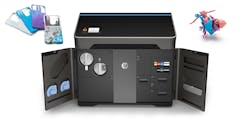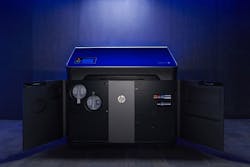HP's New 3D Printers Make Engineering-Grade Parts Affordable to All
Since 2016, you may have looked at HP's line of industrial-grade Jet Fusion 3D Printers, which start at $120,000, and imagined a day when your business could afford a solution to quickly and cheaply print prototypes and production-ready engineering-grade parts. You may work with a lot of Fortune 500 companies, but you can't spend like them, so you're left with pangs of technology envy and a yearning for the far-away day when the ROI for your modest production volume makes sense.
Today HP announced today that the wait is over. A new array of compact Jet Fusion 3D printers, the 300/500 series, is about to hit the market at almost a third of the price of the advanced 3200/4200/4210 models, keeping the same Multi Jet Fusion technology. Those boast ten times the speed at half the cost of similar additive solutions.
In the process, one nozzle jets a fusing agent onto the material layer, followed by a detailing agent to create a finer, smoother resolution. A lamp blasts heat energy to selectively fuse the part and the excess powder can be reclaimed. The end result is a stronger, highly detailed part created in a "fraction of the time" of comparable fused deposition modeling (FDM) solutions.
They will be available in full color (580/380) or black and white (540/340).
The potential for opening up this level of voxel (3D pixel) control at this price point is intended to obliterate the technological barrier to innovation.
"HP is committed to democratizing 3D design and manufacturing, unleashing new possibilities for millions of innovators around the world," said Stephen Nigro, HP's president of 3D printing, HP. "No matter your industry, no matter your design complexity, no matter what colors fit your business needs—black, white or the full-color spectrum—the new HP Jet Fusion 300/500 series gives you the freedom to create brilliant new parts liberated from the constraints of traditional production methods."
This means research organizations, universities, small businesses, and startups now all have access to making high-quality components at their facilities, speeding up the innovation process.
“I'm excited about the range of applications for functional multi-color 3D printing,” said Terry Wohlers, president of Wohlers Associates Inc. “It's good to see that HP is targeting this interesting and largely untapped opportunity. The possibilities are infinite.”
HP also introduced a new material similar in mechanical properties to what's used in the original Multi-Jet machines called HP PA Color Boost (CB) 12. They are available to order now and are expected to be delivered in Q2 2018.
In short, now you have no need to feel envious, and every reason to feel excited about the possibilities.
Here are the specs:
Model: 580/540, 340/380
Printable Build Size: 190 x 332 x 248 mm, 190 x 254 x 248 mm
Printer Dimensions: 1,565 x 955 x 1,505 mm, 1,565 x 955 x 1,505 mm
Productivity: Full bucket with 52 parts in about 15 hours, as many as 5 parts in around four hours
Color: Full Color, Black and White
Layer Thickness: 0.08 mm
About the Author
John Hitch
Editor, Fleet Maintenance
John Hitch, based out of Cleveland, Ohio, is the editor of Fleet Maintenance, a B2B magazine that addresses the service needs for all commercial vehicle makes and models (Classes 1-8), ranging from shop management strategies to the latest tools to enhance uptime.
He previously wrote about equipment and fleet operations and management for FleetOwner, and prior to that, manufacturing and advanced technology for IndustryWeek and New Equipment Digest. He is an award-winning journalist and former sonar technician aboard a nuclear-powered submarine where he served honorably aboard the fast-attack submarine USS Oklahoma City (SSN-723).



